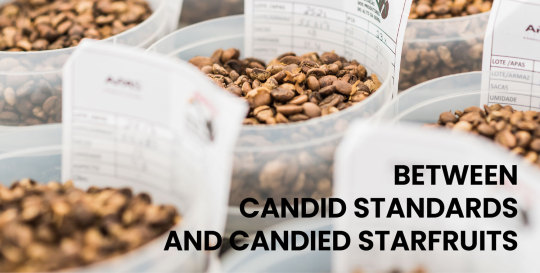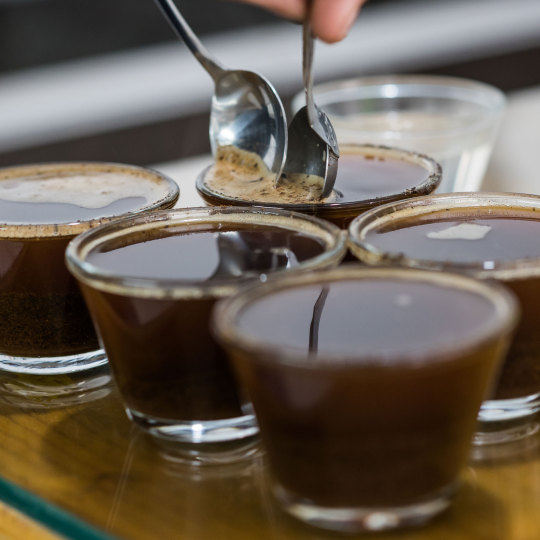In the last blog post we had a closer look at the most common standards for evaluating coffee: The scoresheets of the SCA and the Cup of Excellence competition.
But what is it actually that these scoresheets are made of? - paper of course. Haha. Seriously: Why these categories and not others? And what if I want to build my own scoresheet?

In this part of our series, we want to look at the scoring of coffee more generally and present the theoretical foundation of how we evaluate coffee.
A scoresheet is only useful in the context in which it was created and in fact many cooperatives, exporters and roasters have developed their own evaluation system to rate coffee. It is, for example, misleading to use the SCA scoresheet for the quality control of roasted coffee because it was developed for green only. They work under the condition that roast and extraction parameters are applied consistently. Therefore one should first ask the question: What is the purpose of the evaluation?
According to the answer, you then adjust your scoring system. Adjusting… hm. Adjusting from what? Is there a framework from which you build your score sheet, something that should always be considered when we evaluate coffee - whether it is for roasting, brewing or green coffee? Indeed there is. Aromatics, Acidity, and Mouthfeel have to be always part of a coffee evaluation. They are the skeleton of every score sheet, the pillars of a coffee, the Big 3.
Aromatics
The aromatic diversity of coffee is huge. You probably have heard that there are about 1000 different aromatic compounds in coffee, which is twice the amount you can find in wine. Less than 40 of them have a significant impact on the coffees’ character but still: The number of possible combinations of those is endless.
But when we talk about aromatics we don’t only mean the smell of the coffee which you can find in the common scoresheets as Aroma.
Flavor and aftertaste are as much a product of the aromatic compounds in the coffee as what you smell as vapors rising from the cup. When you “taste” starfruit in a coffee it is a series of volatile chemical compounds rising into your nasal cavity to stimulate your olfactory receptors. This can be altered or enhanced by slurping (flavor) or swallowing (aftertaste). In that sense, The category “aromatics” can be defined as the entirety of the volatile compounds in your cup. In the Cuppers Handbook it is also referred to as the bouquet.
Acidity
The acidity is like the backbone of every coffee. It brings life to the cup and can lift aromatics and the perceived sweetness to a tickling and stimulating experience. Even styles like dark roasted espresso blends need a certain amount of acidity. Without it, the coffee would be horribly flat and boring. On the other side, acidity can be totally overbearing and generally, humans have a quite low tolerance for it. I probably don’t need to mention the great specialty dilemma of creasing customer faces from “light roasted” espressos. At its best, though, it can create a superb experience through a combination of numerous different acids such as citric, quinic, chlorogenic, malic, tartaric, acetic, lactic or phosphoric acid. They all have a different expression but are measurable and can their perception can be trained.
Mouthfeel
The word describes it very well. How does the coffee feel in your mouth? It means the tactile sensation of the liquid on your tongue and is one of the most interesting and complex aspects of a coffee. An effort to capture it in a more narrow category resulted in the term “body” which is more related to the intensity than to the actual character of the tactile sensation. Beyond the intensity, we look at the mouthfeel often as texture or structure which is maybe difficult to grasp but pays tribute to the subtle nuances of a coffee and the effect of cooling on the perceived density of the liquid. This is also because the chemical compounds responsible for the creation of mouthfeel are versatile. Lipids (fats) play a major role in the weight and texture of a coffee. Dissolved carbohydrates (fiber) add to the mouthfeel and also Trigonelline, Caffeine and chlorogenic acids as sources of bitterness have an important impact on the mouthfeel. The winning coffee of World Brewers Cup Champion Emi Fukahori was of the Laurina variety which has 50% less caffeine content than a usual Arabica variety. This created an interestingly round mouthfeel in her coffee.

Photo by Rodrigo Torii
How to build a score
In order to compare coffees side by side, a numerical rating system can be useful - On most scoresheets, we give attributes a value from 1 to 10. Not always is this really helpful to understand coffee as we will discuss later but for now, let’s discuss how a score is built. While it might be obvious to someone that a high sparkling acidity is better than a neutral one we have to ask ourself why we judge like this. It isn’t as self-explaining as we might think. The sour vs. acidity dilemma many baristas experience with their customers in specialty coffee shops makes that all too clear.
A helpful approach when looking at the Big 3 is to use the parameters Quality, Intensity, and Complexity.
Quality means how good an aspect is. When we taste something in our coffee we first access whether it is positive or negative. It sets the direction in which it will influence the rating of the attribute the particular feature belongs to. Then we consider the intensity of this feature. This will multiply the quality - either in a negative or positive direction. The higher the concentration of a positive aromatic component in the cup the better. For acidity, this has strict limits of course but if you think of strawberry aroma for example: Well… who could get enough of that?
When you can find a series of flavors in the cup we consider the coffee to be complex. Complexity is a rather odd one and sometimes just inexpressible. When there is just so much going on, that you can’t explain it all in detail - that’s complexity. A dynamic change of the attribute as it cools can also be an indicator of complexity.
These three parameters should also be looked at in the order presented.
Quality has come first because the highly intense aroma of rubber is really not for you are looking for. Also, complexity doesn’t justify a high score if the intensity is so low and you can bare taste anything of what is supposedly complex.
How we integrate this assessment into a numerical hierarchy is now only a matter of calibration. Once you are given reference points for what for example a 6 or 8 acidity you will be able to adjust your scores accordingly. This is what happens during a Q-Grader Certification or Calibration Course.

Sweetness and balance
Maybe you asked yourself why sweetness isn’t part of the Big 3. Isn’t it even the most important aspects of coffee? Of course, the perception of sweetness plays an important role. But there is one big problem: There is actually no sugar in coffee that could make sweetness quantifiable. Green coffee contains up to 10% simple sugar chains like Sucrose which mostly caramelize or become products of the Maillard reactions during the roasting process. After roasting only traces of free sugars remain. On average we are left with less than one gram of actual Sucrose in a 300 ml filter brew. So what is it then that makes a coffee appear sweet?
If we look at the composition of a cup of coffee, the highest percentage of dissolved solids comes from fiber (up to 800 mg/100 ml). It is also made up of carbohydrates, but the long sugar-chains version called polysaccharides. They are not sweet in taste but produce a density and mouthfeel in a coffee can give the impression of sweetness in the cup. Some of the soluble fibers found in coffee are also used as thickening agents in the food industry.
Another aspect of sweetness is what we rather smell as compounds tightly linked to sweetness in our memories - Maillard products (a result of complex reactions between amino acids and reducing sugars) and products of caramelization.
They are responsible for the aromatics of coffee and result in almost all coffees in notes of caramel, vanilla, chocolate, etc. These aromas often appear in sweet food products and we are quite conditioned to associate them with sugar. The same counts for intensely fruity coffees with a balanced acidity which sometimes feel like drinking juice.
A scoresheet that has taken this entangled and slightly ambiguous character of sweetness into account is the World Brewers Cup Scoresheet on which you cannot find cannot find a separate column for sweetness.
However, it can make sense to distill an attribute like Sweetness from the Big 3 if it is a characteristic you are trying to emphasize. Especially in roasting we often put a focus on such relative attributes as we are trying to create synergy in a coffee.
Another attribute of this kind is Balance. Its goal is to put aromatics, acidity, and mouthfeel into relation to each other. It helps us to talk about the holistic picture of the coffee and describe how the individual aspects come together as one. Also how the coffee changes as it cools should be looked at here. Describing the cup as a whole is often the more natural approach we take to tasting coffee. All the different attributes that we first separate conceptually can be rated as a total under Balance A great coffee has an inner harmony that creates a wholesome cup experience.
But should relative attributes be actually captured in a separate score?
Technically it isn’t necessary to give a separate rating on balance. All arguments why the balance of a coffee is high or low can also be given in the individual attributes it puts in relation to each other. When the acidity is overpowering why wouldn’t one score this lower in Acidity in the first place?
What is much more important when it comes to relative attributes is to work descriptively. A scoresheets’ purpose is not solely to end up with a final total score to say: It’s a 90+ coffee!. The purpose of most cuppings is to evoke discussion and communicate up and down the supply chain to make coffee better.
Why is the acidity not working well in this coffee? Could the balance be improved with a richer mouthfeel? Or why is this an unusual Brazilian coffee?
This descriptive aspect of a scoresheet is what matters most.
Numerical scoring is necessary to help to match standards or keep an overview of a larger number of coffees.
As a Liaison between growers and roasters we have to provide not just a quality assessment to roasters but also offer qualitative feedback to the producing side. In our daily work, we use cupping scores mainly to remain calibrated with the producer and exporter and control the consistency from farm to warehouse. This we do based on the Big 3 - aromatics, acidity, and mouthfeel. Rating coffee is only a tool which becomes useful when we combine it with concise language.
How we describe coffee linguistically will be the focus of the third and last part of this blog post series.




Let Us Know What You Thought about this Post.
Put your Comment Below.